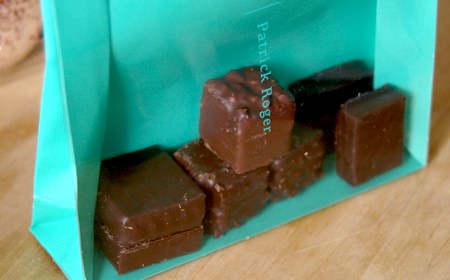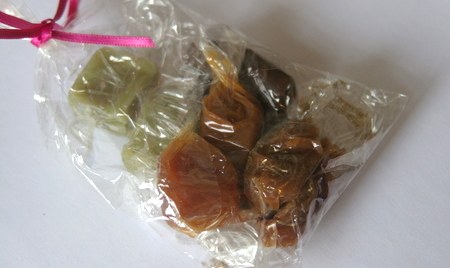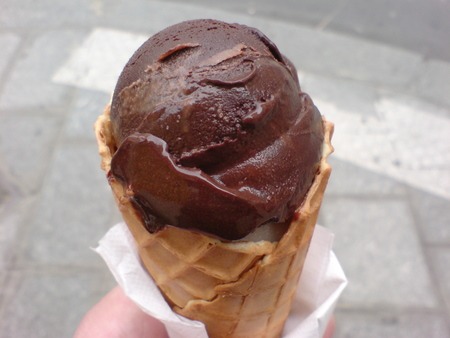All over Denmark you see signs for frisky creamy balls. At first it seems very odd and rather tasteless, until you realise you’re mistranslating. You see, friske flødeboller actually means fresh cream balls. A world of difference in the world of smutty word games.

I’m in Denmark as I write this, sitting in a lovely IC3 train (the quiet section, stillezone) on my way from Copenhagen to Odense. A few weeks before leaving Australia for rather chilly (but delightfully sunny and springy) Scandinavia, I was inspired to make the aforementioned smut objects by the talented baker and cake decorator Sif of anarka.dk. Earlier this year she published a recipe for flødeboller and I knew that these creations just had to happen in my kitchen too.
As a child I had a perverse affection for the Rowntree’s (now Nestlé) Walnut Whip, largely restricted to the British Isles. Cheap and nasty milk chocolate encased a fluffy interior of a sort of artificial cream. Atop the Walnut Whip sat a walnut, slightly rancid and squeaky. Little has changed other than the price.
In my late teens I was exposed to the German Dickmann’s (Schokoküsse): domes of neutral fluff on a wafer base altogether covered in a thin layer of chocolate. These things can be found in various forms around the world, often having the rather unfortunate name of n-gger kisses, moor heads and the like. (Sorry for the self-censorship, but I can do without white supremacists finding this site!) They continue to exist with, thankfully, rather less old-fashioned names. Wikipedia’s English language article on these is pretty fun.

Flødeboller are fun or hell to make, depending on your perspective on meringue and chocolate coating. This is not a recipe for a humid or warm day. Here comes my account.
Bases
SIf’s original recipe uses dried marzipan discs (a marcipanbund) as the base, Swiss meringue for the filling and milk chocolate for the coating. I was giving my flødeboller as gifts over about 10 days so decided to use an effective method for pasteurising the egg whites at home: heated Italian meringue. During production I found that I had undercooked the marzipan bases a bit and that they soften too much over time (some manufacturers coat the marzipan completely in chocolate). I’m not sure if a shortcake or biscuit base might be a better option, especially for longer storage. Many recipes use a wafer base, but it’s not my preference. I feel you’d need a base which is fairly firm but not too crisp/crumbly.

With 200gm of marzipan, make discs 4-5mm thick and whatever diameter you prefer (I tried 5cm) or prepare biscuits/wafers of similar dimensions. If using marzipan, you’ll need to dry the discs in a 200C oven, being very careful not to burn them (Sif says less than 5mins). The discs are very soft until they have cooled.
Meringue
Sif uses commercial pasteurised eggs for safety (a very common concern in parts of Europe and North America). As pasteurised eggs aren’t always easy to obtain, I’ve used a special Italian meringue.
I used approx 100gm egg white (about three egg whites) and 150gm sugar. In order to ensure home pasteurisation of the egg whites, I warmed the egg whites gently in a bowl over hot (approx 50C) water, then added hot sugar syrup.
First, prepare a sugar syrup by adding about 20ml water to the sugar in a small saucepan and then simmering it until it reaches a target temperature of 110-120C (you don’t need to be particularly precise). Very shortly before the syrup reaches its target temperature, place the egg whites in the bowl over the hot water and start beating slowly. The goal is to raise the temperature of the egg whites so that the combined temperature of syrup and egg whites will stay above the threshold for pasteurisation for long enough to be effective.
When the egg whites form soft peaks, place the bowl on a flat surface and add the syrup while whisking at high speed until the meringue is very stiff. Allow to cool.
When the meringue is cool to the touch you can pipe it onto the discs, using whatever pattern/nozzle you prefer. You could flavour the entire batch of meringue, divide it into different bowls for different flavours, or add certain flavours after piping. The piped meringue should stand at room temperature for at least an hour or two so that the surface is fairly dry to the touch.
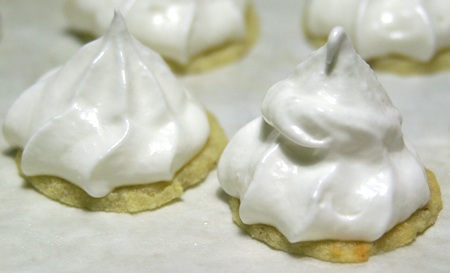
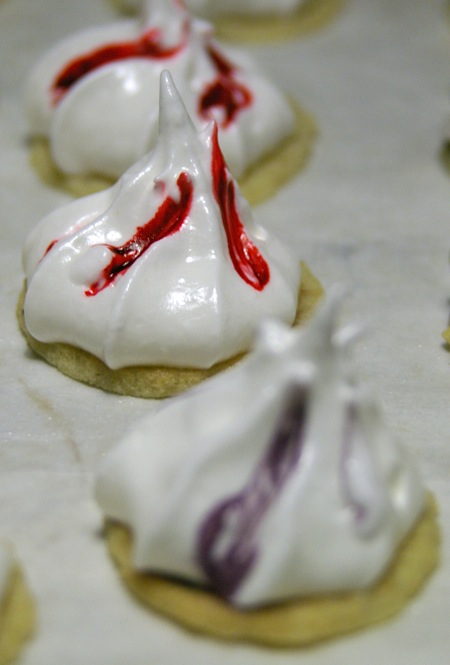
Chocolate
Gently melt about 200-250gm dark chocolate (I wouldn’t go over 60% cocoa). I suggest having a large pointed spoon and a small teaspoon to hand for coating the meringues. The discs with meringue should be placed on a thin wire drying rack. Place freezer plastic or baking paper underneath the rack (you’ll want to catch the chocolate that runs off so that it can be recycled). Let the chocolate cool to slightly warmer than skin temperature before coating the meringues (otherwise the meringue may soften a lot).
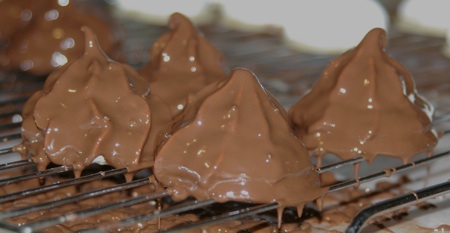
Drizzle the chocolate over the meringues, taking care to patch any holes you might miss at first. The chocolate should form a seal around the entire meringue, but it isn’t necessary to coat the bottom of the discs. Apply any decoration before the chocolate stiffens. Place the finished flødeboller on baking paper or waxed paper before the chocolate stiffens (it’s not fun when the chocolate hardens while the flødeboller are still on the wire rack, because they then break when you try to remove them).
The chocolate will take a long time to harden. It is best to leave the flødeboller in a cool place for a number of hours. Then eat them all.

If you forget to eat some, make you sure you keep them in a sealed container in the fridge.

